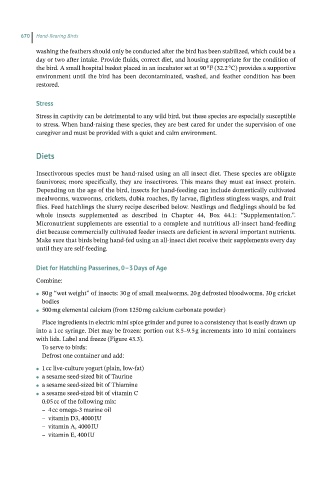Page 669 - Hand rearing birds second
P. 669
670 Hand-Rearing Birds
washing the feathers should only be conducted after the bird has been stabilized, which could be a
day or two after intake. Provide fluids, correct diet, and housing appropriate for the condition of
the bird. A small hospital basket placed in an incubator set at 90 °F (32.2 °C) provides a supportive
environment until the bird has been decontaminated, washed, and feather condition has been
restored.
Stress
Stress in captivity can be detrimental to any wild bird, but these species are especially susceptible
to stress. When hand‐raising these species, they are best cared for under the supervision of one
caregiver and must be provided with a quiet and calm environment.
Diets
Insectivorous species must be hand‐raised using an all insect diet. These species are obligate
faunivores; more specifically, they are insectivores. This means they must eat insect protein.
Depending on the age of the bird, insects for hand‐feeding can include domestically cultivated
mealworms, waxworms, crickets, dubia roaches, fly larvae, flightless stingless wasps, and fruit
flies. Feed hatchlings the slurry recipe described below. Nestlings and fledglings should be fed
whole insects supplemented as described in Chapter 44, Box 44.1: “Supplementation.”.
Micronutrient supplements are essential to a complete and nutritious all‐insect hand‐feeding
diet because commercially cultivated feeder insects are deficient in several important nutrients.
Make sure that birds being hand‐fed using an all‐insect diet receive their supplements every day
until they are self‐feeding.
Dietfor HatchlingPasserines,0–3Daysof Age
Combine:
80 g “wet weight” of insects: 30 g of small mealworms, 20 g defrosted bloodworms, 30 g cricket
●
bodies
500 mg elemental calcium (from 1250 mg calcium carbonate powder)
●
Place ingredients in electric mini spice grinder and puree to a consistency that is easily drawn up
into a 1 cc syringe. Diet may be frozen: portion out 8.5–9.5 g increments into 10 mini containers
with lids. Label and freeze (Figure 43.3).
To serve to birds:
Defrost one container and add:
1 cc live‐culture yogurt (plain, low‐fat)
●
a sesame seed‐sized bit of Taurine
●
a sesame seed-sized bit of Thiamine
●
a sesame seed‐sized bit of vitamin C
●
0.05 cc of the following mix:
– 4 cc omega‐3 marine oil
– vitamin D3, 4000 IU
– vitamin A, 4000 IU
– vitamin E, 400 IU

